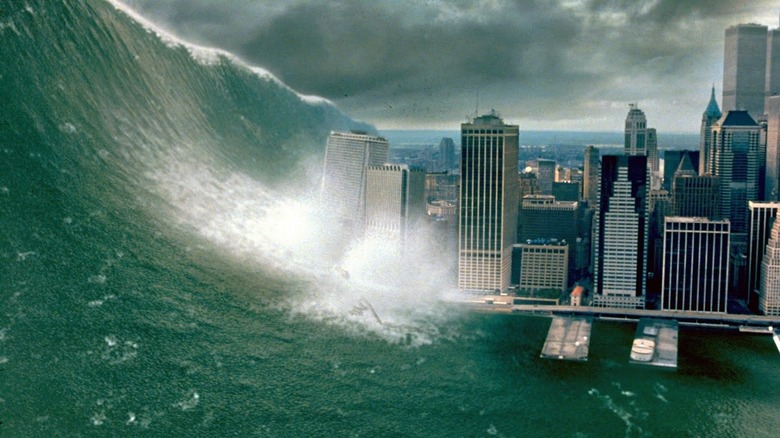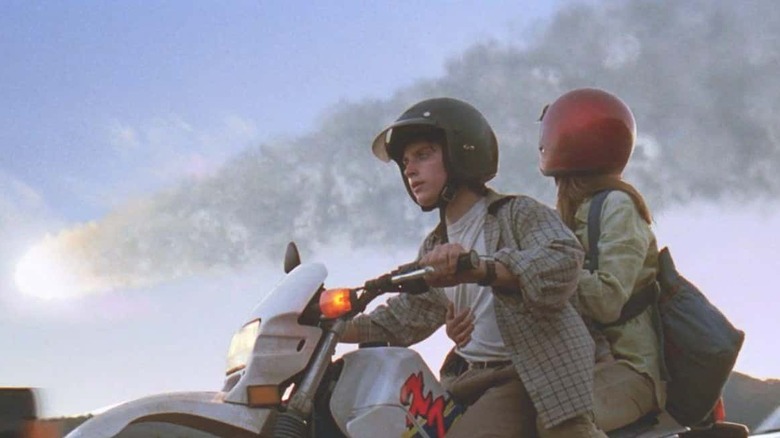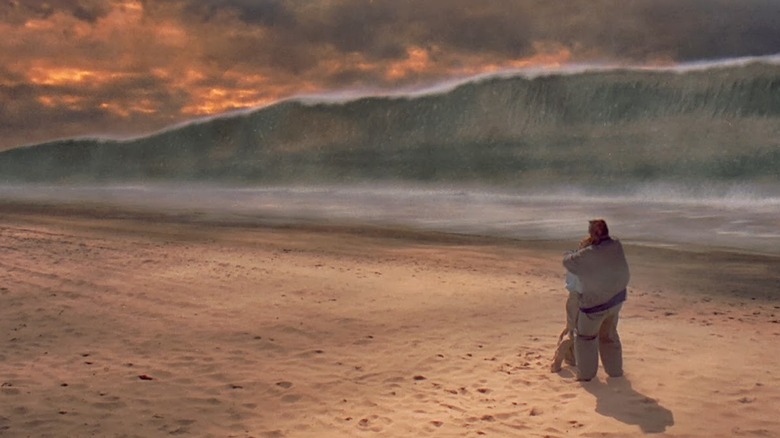Deep Impact's Sci-Fi Premise Was More Science Than Fiction
It's practically impossible to talk about Mimi Leder's 1998 comet-based disaster film "Deep Impact" without also cursorily mentioning Michael Bay's 1998 comet-based disaster film "Armageddon." Leder's film was released on May 8, and was presented as a stern and realistic view of what might happen to the Earth if a massive, Mount Everest-sized comet struck. Bay's film was released on July 1, and presented a much more cartoony, ultra-macho version of the same story, this time with a comet the size of Texas. The former was about somber politicians planning for the worst, the latter was about muscular, blue-collar miners flying into space. Curiously, both films were hits; "Deep Impact" made $350 million on a budget of $80 million, and "Armageddon" made over $550 million on a budget of $140 million.
Of the two, "Deep Impact" is the "classy" choice, featuring a wide ensemble of recognizable actors, each doing their best to prepare for — and then survive — a comet impact. In Leder's film, Morgan Freeman plays the President of the United States, while Téa Leoni plays the investigative journalist who discovers that the government knows all about a mysterious potential E.L.E., or extinction-level event. Leoni's parents are played by Vanessa Redgrave and Maximilian Schell. Elijah Wood and Leelee Sobieski play the teen lovers, while Jon Favreau, Blair Underwood, James Cromwell, and Robert Duvall also appear.
In 2023, to celebrate the 25th anniversary of "Deep Impact," Salon printed an interview various scientists, environmental activists, and astronomers, and they all extolled the film's surprising attention to scientific detail. Most Hollywood sci-fi films, as we all know, are total hokum (a fact that Neil deGrasse Tyson regularly reminds us of), so it was notable that "Deep Impact" possessed a certain level of scientific verisimilitude.
Dr. Joshua Colwell was a professional comet advisor on Deep Impact
Multiple astronomers were hired to serve as consultants on "Deep Impact," employed to assure the comet science would be as accurate as possible. The team included Gene Shoemaker — the co-discoverer of the Shoemaker-Levy 9 comet — astronaut David Walker, Chris Luchini, and Joshua Colwell, a physics professor at the University of Central Florida. Colwell noted that:
"It's not hard to be more scientifically accurate than most sci-fi movies. [...] [The] director, producers, and writers made a decision to make the movie as realistic as possible while staying true to the story they were telling. [...] The movie depicts both an attempt to deflect the comet and also the creation of a subterranean 'ark' to house a large number of people to survive the catastrophic and long-lasting effects of the impact. [...] Both of these activities are plausible, but both require huge resources and a lot of time to put together."
Colwell and the other advisors also made sure the surface of the comet looked correct, and that it was a scientifically accurate size; in the case of the movie, it was seven miles across. They also wanted to make sure that the strike looked like an actual comet strike might, posited what would happen to Earth's oceans (there is a massive, city-swallowing tidal wave), and were careful to show that any astronauts who visited a comet would still be weightless while close to its surface.
For the record, any heavenly body with gravity would necessarily, thanks to a process called isostatic adjustment, be spherical. The smallest spherical body with its own gravity in the solar system is Mimas, the seventh-largest moon of Saturn, which is about 246 miles in diameter. Meanwhile, the largest comet known is C/2014 UN271, which is only about 1.2 miles in diameter.
Not all sci-fi films need to be accurate
As mentioned, one of the plot points of "Deep Impact" was the construction of underground bunkers wherein some humans would be able to survive the impact and the disaster's aftermath. This was a plot point later repeated in the 2009 disaster film "2012," although that film was not as concerned with scientific accuracy.
Back in 2010, Dr. Sidney Perkowitz, a physics professor at Emery University, famously criticized Hollywood's habits of scientific inaccuracies, a criticism that, in his mind, came to a head with the release of Jon Amiel's "The Core" in 2003. "The Core" was a disaster film about how the Earth's core had ceased rotating, and how a brave team of scientist adventurers had to burrow down to it to explode a nuclear bomb. The idea is that the explosion would restart the rotation. It was all hooey, of course, and Perkowitz wasn't shy about saying so. The terminology used in "The Core" was inaccurate, no one writing the film understood how physics works, and the film, to Perkowitz's eyes, suffered as a result. "The Core" led to the creation of the Science & Entertainment Exchange, an organization devoted to retaining real scientific principles in sci-fi movies. If the science is accurate, maybe casual viewers would develop an interest in pursuing scientific careers.
The Science & Entertainment Exchange was merely a pipe dream five years earlier, when "Deep Impact" was being made, but one can see that filmmakers and scientists were already working together to keep Hollywood honest.
Not all sci-fi films need to be 100% accurate, of course. I'd rather see "streaking" stars as a "Star Trek" ship travels at faster-than-light speeds than the star "haze" one might more accurately see out a window. But real physics, when possible, are vital and appreciated.


